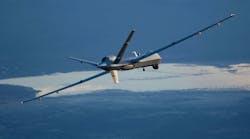Machines are replacing men on the battlefield. If there was any doubt in this trend, it should be dispelled by the latest announcement from General Atomics Aeronautical Systems (GA-ASI) that its Predator series of remotely piloted aircraft (RPA) has surpassed 6 million flight hours. The company’s unmanned aerial vehicles (UAVs), which include the Predator, Predator B, Gray Eagle, Avenger, and MQ-9B SkyGuardian aircraft, completed 430,495 total missions. Close to 90% of those missions were flown in combat.
“Six million flight hours is a testament to the reliability of our unmanned aircraft systems that are designed, built, and sustained by a dedicated group of skilled and innovative professionals for operations around the world,” said Linden Blue, GA-ASI’s CEO. “In our more than 25 years in business, GA-ASI has achieved a list of historic ‘firsts’ in RPA development and we have leveraged those accomplishments to better support our customer’s requirements.”
The long flight hours are evidence of increasing reliance on robotic systems for tactical missions. At any time during the day, typically 69 Predator-class RPAs are airborne around the world. The medium-altitude, long-endurance (MALE) UAVs perform such tasks as reconnaissance, surveillance, and target acquisition using onboard payloads that include electro-optical (EO) and infrared (IR) cameras and line-of-sight (LOS) wireless communications radios. The trend of increasing UAV use is obvious from the flight hours, which totaled 500,000 hours from 1993 to 2008, reached the 1-million-hour mark in 2010, the 3-million-hour mark in 2014, 5 million hours in 2018, and now 6 million hours.
“The demand for persistent situational awareness using our RPA is demonstrated daily through the accumulation of flight hours. The demand for our aircraft is consistently answered by our team of employees, suppliers, and partners who work hard to meet our customers’ dynamic mission requirements,” said David R. Alexander, GA-ASI president. “Because of the dedication of our employees, our suppliers and partners, our aircraft have the highest mission capable rate in the USAF aircraft inventory.” The RPAs are used by the U.S. Army, Air Force, Marines, NASA, and many international allies.

